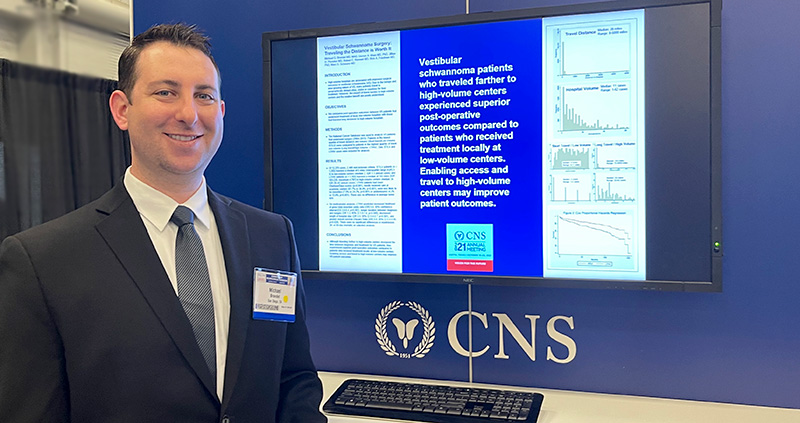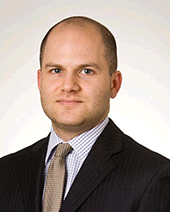Resident Life

A Day in the Life of a UC San Diego Neurological Surgery Resident
The typical day of a neurosurgery resident depends on whether that resident is a junior resident (Intern, PGY-2, PGY-3), research resident (PGY-4, PGY-5), or senior resident (PGY-6, PGY-7).

The junior residents work hard, and they are what keep the neurosurgery service running. A typical day starts early in the morning, where they'll arrive at the hospital first and pre-round on the patients, receiving sign-out from the overnight provider and then reviewing charts and imaging. Once they're briefed on overnight events, the juniors will then proceed with examinations for a select group of patients. The senior residents will then lead rounds for the morning, reviewing the data presented by the juniors, asking questions, and performing targeted patient exams. Once rounds are complete, the team will usually go to the cafeteria and grab a quick breakfast while running through the plans for the day.
The senior and junior residents will break off and head to the operating rooms, while the interns will head to the floors and to the ICU to update other teams, nurses, and families with the plan of care for the day. The intern holds the pager and is the first to respond to any new consults and answer questions / communicate with other teams. Periodically throughout the day, the intern will update the senior residents about the status of patients, new consults, and other service events.
Faculty are in regular communication with the resident team to ensure appropriate support for clinical plan development and facilitate ongoing training and instruction.
The remainder of the resident team will spend the majority of the day in the operating room, and typically each resident is assigned to a different surgery. The senior resident will assign residents to different operating rooms based on their abilities, preferences, and seniority.
Once operations conclude for the day, the team will get back together in the evening and review events from the day, and see any new consults or critical patients. The team will run through the plan for the evening, and then a junior resident will take over the pager for overnight call.
Research residents have the greatest degree of autonomy, and their day depends entirely on whatever career development path they are pursuing.
In general, Monday through Thursday run as described above. Friday mornings are reserved for protected educational time, and the Grand Rounds program may include local or guest speakers, or a Morbidity & Mortality (M&M) review. The hour after Grand Rounds is reserved for resident education, and may include faculty-resident didactics, board review sessions, journal club and periodically hands-on cadaver labs. After the educational programs have concluded, the residents may return to the operating room or to the afternoon resident-run clinic in Hillcrest.
Life in San Diego
San Diego is a vibrant, multicultural city known for its beautiful beaches, world-renowned attractions such as the San Diego Zoo and Balboa Park and strong arts and culture scene. We are home to several pro sports teams, including the San Diego Padres and San Diego Wave FC, as well as Comic-Con, the largest comics and pop culture event in the United States.
Our close proximity to the U.S.-Mexico border makes us a truly binational city, with 20% of the population speaking Spanish, and the city's Convoy District is among the largest Pan-Asian business districts in the nation. Additionally, our city's annual San Diego Pride Parade is one the largest Prides in the nation, attracting more than 300,000 people, and the largest single-day civic event in the region.
A Resident's Point of View
 UC San Diego Neurological Surgery is delighted to welcome Jeffrey Steinberg, MD to our faculty.
UC San Diego Neurological Surgery is delighted to welcome Jeffrey Steinberg, MD to our faculty.
Before completing his neurosurgical residency at UC San Diego, Dr. Steinberg received his Bachelor of Science in Biopsychology from UC Santa Barbara and Doctor of Medicine degree from Albany College.
From 2016-2018, Dr. Steinberg received specialized endovascular training through our Department's CAST-certified Neurovascular Fellowship. During this period, he completed an enfolded experience in open cerebrovascular revascularization at Stanford University. His publication record and academic focus as a resident centered on the skull base laboratory.
A dedicated teacher, Dr. Steinberg was the recipient of the Kaiser Excellence in Teaching Award, voted on by MSIII and MSIV Medical Students at UC San Diego, in 2018. We look forward to his continued leadership as a faculty member in residency education, development of a cerebrovascular practice, and spearheading efforts for the department at the Center for the Future of Surgery.
What drew you to the field of neurological surgery?
I was drawn to the field of neurological surgery to merge my interests in engineering with translational neurosurgery. The field has limitless possibilities. The technical aspects of the field mixed with the fascinating nervous system physiology and pathology.
At what age did you realize you wanted to pursue a career in the medical field?
Early in graduate engineering school. During undergraduate studies studying biopsychology.
What qualities and/or strengths do you believe make a successful resident?
Self-motivated, careful, honest, personable, and reliable.
What do you believe are some of UC San Diego's greatest strengths as a program?
I wanted the opportunity to rotate at several different hospitals, which UC San Diego provides, including a trauma public-sector-oriented hospital, large academic hospital, VA and children's hospital. The diversity at these hospitals is invaluable. We have faculty who are specialists in a multitude of areas including deformity corrections, skull base, cerebrovascular, functional and pediatrics. This dedicated training, along with the strong general neurosurgery presence, allow for a fantastic training environment.
What attracted me to UC San Diego was the people in the Department. The resident group is responsible and hardworking, as well as fun to be around. The faculty are skilled, and in many cases national leaders in their fields, yet very approachable and easy to work with. Finding a group of people I fit in with was one of the keys for me when selecting a program. After being here, the early operative exposure and the progressive autonomy after learning the requisite skills have been critical to my ongoing happiness.
What valuable opportunities are presented to you that you will only find at UC San Diego?
The collaboration with UC San Diego engineering and other faculty in our sister Department of Neurosciences is top-notch. The mission is collaborative and benevolent.
